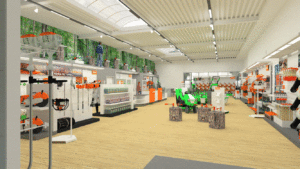We asked web professionals: what awaits us for the web design industry in the next 20 years?
These were our predictions for the future of the web earlier this year.
“CSS in JavaScript is a big change in the way we design applications”, “It’s moving away from the idea that HTML is content, CSS is what it looks like, and JavaScript is what it does.” But he’s still totally in favor of it. “Focusing on building reusable components solves a lot of problems,” he argues. “I think it’s good to change the way we do things from time to time, to see if we can improve it.”
And the payoff for all of this is that web experiences will be faster and cheaper to create.
“Building websites used to be slow, expensive and difficult to maintain. And it also meant you had to have a lot of skills, a lot of people. Now we’re putting the power back in the hands of product makers. Which means you can spend less time keeping these applications, more on the needs of customers. Conversing with them, building the things they need.” And how should we find out what users need? Interestingly, that is something that is also changing…

Conversational interfaces
Understanding how users think and what they need will be key to knowing how to implement new technologies. And that certainly applies to another major cultural shift on the web; to chat interfaces. Because the biggest problems here won’t be the technical ones, they will be the human ones.
Many of the challenges we’ve seen around conversational interfaces align very closely with the challenges around inclusive design: mental models, language, trust, etc.
Conversational interfaces change the game in a way we haven’t seen before in web design. “It’s a big step away from a traditional screen-based interface, where people can take their time to navigate and search for supporting information, policies, terms and conditions.”
“When you have a screen, you have something that is constantly giving you cues and keeping you on track, but for conversational interfaces, it’s all in your head. That makes exploratory research much more difficult for people.” .
That’s not to say there isn’t a genuine place in the market for them. “For example, consider places where people use their hands a lot, like production lines, manufacturing, and laboratories.” “Interfaces that allow people to keep their hands busy when interacting with systems offer clear advantages.”
Web animation
If chatbots take off, writing skills may be as important to the industry as visual design skills are right now. And here’s another creative skill that will be increasingly in demand: animation.
Yes, once we got rid of the old and annoying animations. But recently they have made a comeback as a useful way to provide instant feedback when a user performs an action and guide them through a process.
Why the change? “UI animation has always been there” “But it’s about finding the balance between making it look fancy and letting the user know that their comments have been recorded, that they’re making progress throughout the site.”
Due to the new popularity of UI animation, it is creating a new demand for trained professionals, he adds. “Now you can specialize in animation on the web, and it’s becoming more recognized as an art in its own right. We live in a digital world where people scroll through 300 feet of content a day, so the more we progress in technology, the more this It’s going to continue to rise.”
VR y AR
A-Frame is an open source framework from Mozilla that makes it easy to create virtual reality experiences on the web.
https://youtu.be/wthwRfF6hSU
Another skill set increasingly in demand by web design studios is 3D. That is the most obvious case when it comes to virtual reality, a very important matter.
And don’t discount augmented reality (AR) either. It may have taken a while, but with the arrival of Apple’s ARKit and Google’s ARCore, things are progressing rapidly. A world is envisioned in which the web will become part of our daily vision.
“You will no longer have a screen, the web will only be part of what you see through your smart glasses or smart contacts.” “So, for example, you go to Waterloo train station and instead of looking at the different screens to find your train, your device already knows where you’re going and shows you the moments that are relevant to you.”



